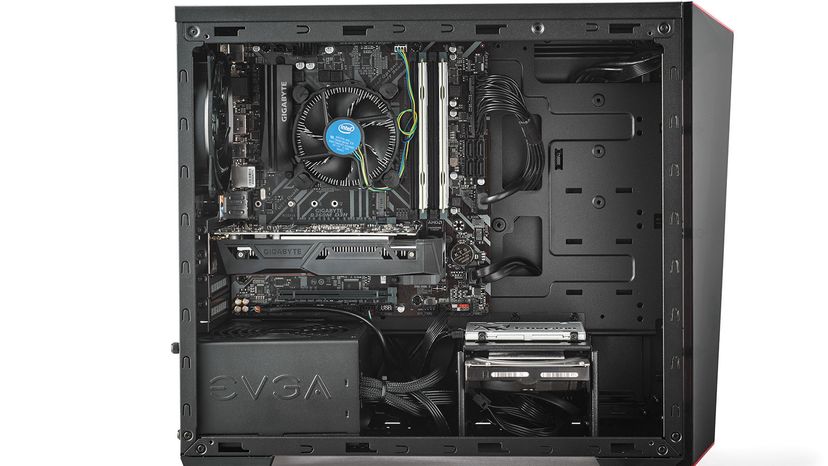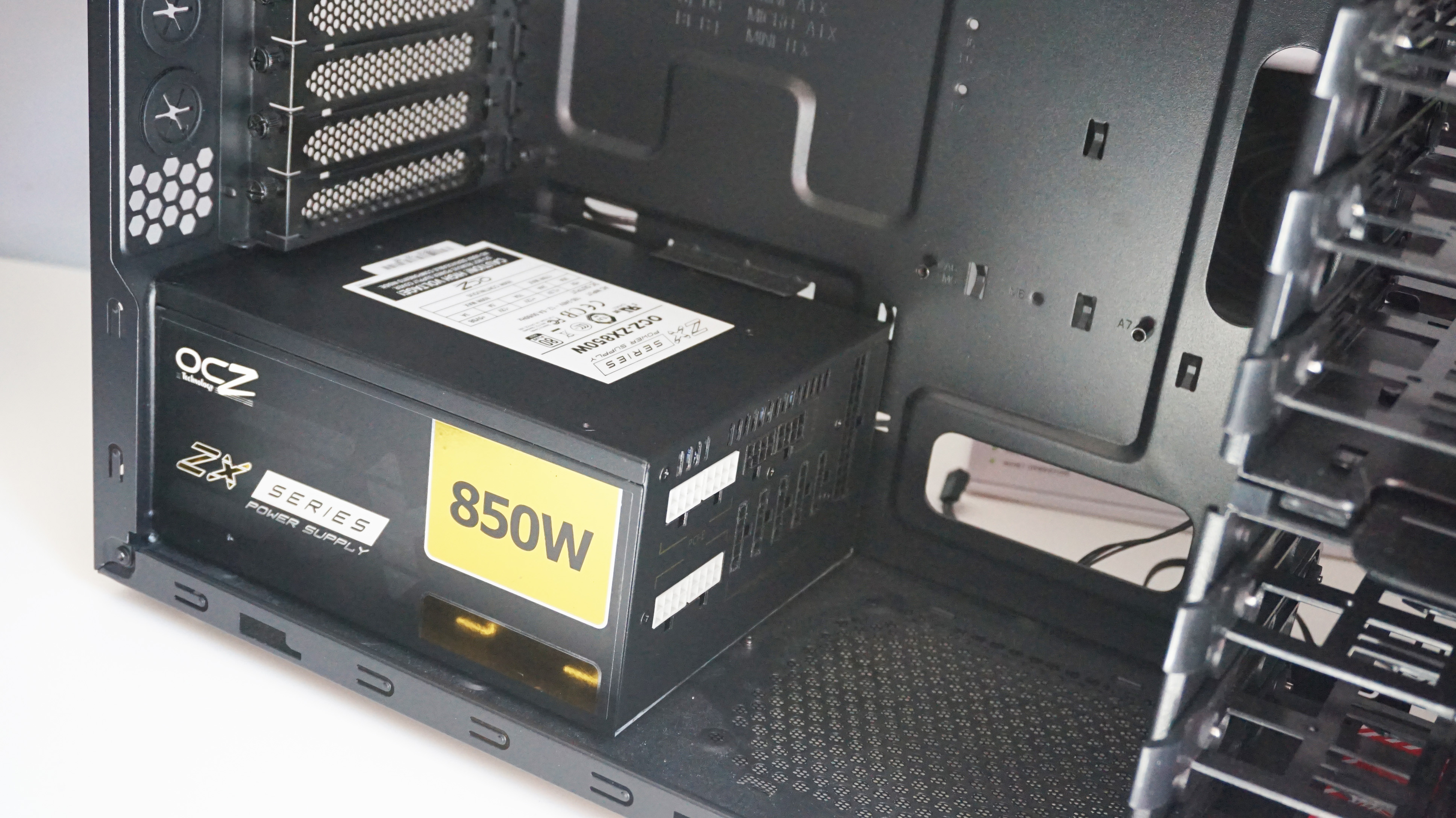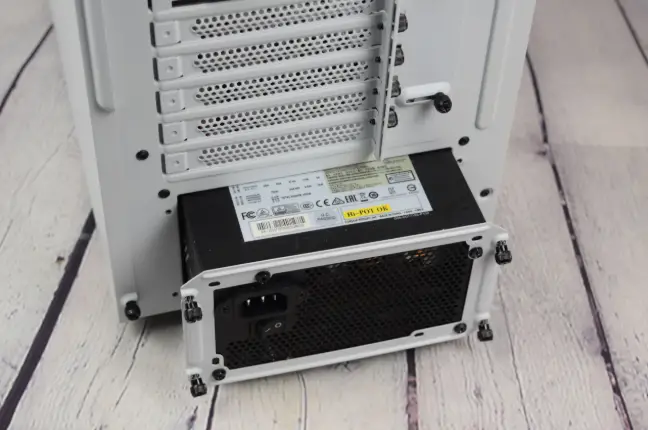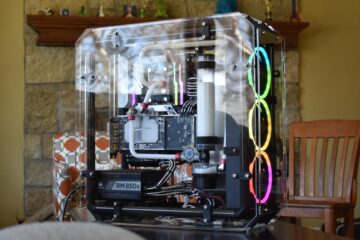A PC case with power supply comes pre-installed with a PSU, offering convenience and compatibility. Such cases can streamline the building process for new PCs.
- The Convenience Of All-in-one Solutions
- Factors To Consider When Buying A Pc Case With Power Supply
- Top Picks For Pc Cases With Power Supplies
- Installation And Setup Tips
- Maintaining Your Integrated System
- Future Trends In Pc Cases And Power Supplies
- Frequently Asked Questions On Pc Case With Power Supply
- Conclusion
PC builders often seek cases with power supplies to simplify their builds and ensure that their components receive a reliable power source. A pre-installed PSU can save time and reduce the hassle of matching power requirements with case constraints. As they shop for components, enthusiasts and beginners alike appreciate the value of a combo that eliminates the guesswork involved in power supply selection.
This integration typically caters to standard build requirements and is especially appealing for those looking to complete a cost-effective assembly. It’s important for buyers to select a case with a quality PSU that meets their specific power needs and adheres to safety standards.
The Convenience Of All-in-one Solutions
A PC case with a power supply offers an all-in-one solution. It simplifies the assembly process. Users save time and effort. This approach can be both cost-effective and space-saving. Let’s dive into the perks of these combined solutions.
Benefits Of Combining Pc Case And Power Supply
- Easy Installation: No need to pick separate parts.
- Space Efficiency: The design uses space smartly.
- Cost Savings: Bundling often reduces the overall price.
- Perfect Match: Components are designed to work together well.
- Warranty: One warranty covers both parts.
Target Audience For Integrated Solutions
First-time Builders: These kits are great for newbies.
Cost-Conscious Gamers: Gamers on a budget appreciate the savings.
Small Space Owners: Anyone with limited space benefits.
Minimalists: Those who love clean setups often choose this route.

Credit: www.pcmag.com
Factors To Consider When Buying A Pc Case With Power Supply
Welcome to our comprehensive guide on choosing the perfect PC case with an integrated power supply. This critical choice impacts your computer’s performance, lifespan, and ease of use. Emphasize key factors that determine the best PC case and power supply combination for your needs.
Compatibility And Dimensions
Ensuring the right fit for your components is vital. Select a case that matches your motherboard size: ATX, MicroATX, or Mini-ITX. Take note of these specifics:
- Measure your space to confirm the case fits.
- Check clearance for GPUs, CPUs, and RAM.
- Include room for future upgrades.
Power Requirements And Efficiency
Select a power unit that supplies enough wattage for your components. Estimate total power needs of CPU, GPU, and other peripherals. Add a 20-30% buffer for peak efficiency.
| Component | Power Usage |
|---|---|
| CPU | 65-105W |
| GPU | 75-350W |
| HDD/SSD | 15-30W |
Consider a power supply with an 80 Plus certification for energy efficiency.
Cooling Systems And Airflow
Adequate ventilation prevents components from overheating. Look for cases with built-in fans or liquid cooling support. Good airflow follows this path:
- Cool air in from the front and bottom.
- Hot air out through the top and back.
Check for mesh panels or vents on the case for optimal air passage. Dust filters are a plus to keep the internals clean.
Related Articles
Top Picks For Pc Cases With Power Supplies
The quest for the ideal PC case with a power supply doesn’t come with a one-size-fits-all solution. Diverse needs call for various features. A thrifty DIY builder seeks different specs than a pro gamer or tech enthusiast. This guide zeroes in on the top-notch options for each category, providing distinct choices for budget-conscious builders, gaming aficionados, and premium users alike. These selections marry quality chassis with reliable power units, ensuring you get the best combo to kick-start your next computer build.
Best For Budget Builds
Affordable yet reliable PC cases with power supplies are pivotal for cost-effective builds. These aren’t just about saving money; they’re about getting the best value.
- Rosewill FBM-X1 – A compact choice with stellar air flow.
- Thermaltake Versa H17 – Sleek design, without breaking the bank.
- Corsair Carbide Series 88R – Versatility meets affordability here.
Optimal For Gamers
Gamers need powerful systems that stay cool under pressure. Cases with robust power supplies deal with demanding games and long sessions.
- MSI MAG Forge 100R – Comes with RGB fans for a stylish, cool build.
- NZXT H510 – Compact ATX Mid-Tower – An iconic design with excellent airflow.
- Cooler Master MasterBox Q300L – Modularity makes this case a gamer’s dream.
Premium Choices For Enthusiasts
Advanced users look for top-tier features and unrivaled performance. These cases provide exceptional cooling, spacious layouts, and are ready for hefty power demands.
- Phanteks Enthoo Pro – A full-tower case for serious builds and future expansions.
- Be Quiet! Dark Base Pro 900 – Silence, flexibility, and high-quality construction.
- Lian Li PC-O11 Dynamic – Boasts a sleek tempered glass design and versatile cooling options.
Installation And Setup Tips
Welcome to our guide on installing a PC Case with a Power Supply. Setting up your new case can be an adventure. Follow these tips closely for a smooth start.
Step-by-step Assembly Guide
Before you begin, gather all necessary tools. These include a screwdriver, your components, and the case manual.
- Unbox and prepare: Remove the case from its packaging. Place it on a clean, flat surface.
- Open the case: Remove the side panels, usually held by screws or latches.
- Install the power supply: Slide it into the designated space at the bottom or top of the case, depending on the design. Secure it with screws.
- Insert motherboard standoffs: These small screws lift your motherboard off the case, preventing shorts. Screw them into the correct holes that match your motherboard size.
- Place the motherboard: Carefully set your motherboard onto the standoffs. Line up the ports with the case’s rear cut-outs. Screw it in place.
- Connect cables: Attach the power supply cables to the motherboard, ensuring a snug fit.
- Add other components: Install your hard drives, graphics card, and any other devices. Connect all required cables.
Note: Some cases with built-in power supplies already have cables routed. Plan your cable management accordingly for a tidy build.
Troubleshooting Common Issues
Problem solving is key to a successful setup. Here are solutions for frequent hiccups:
- Power issues: Make sure the power supply switch is on. Confirm cable connections.
- Boot failures: Check if the motherboard standoffs are installed and there are no shorts. Ensure all components are properly seated and cables are connected.
- Noisy operation: Verify fans are not obstructed. Double-check fan installations.
- Overheating: Confirm that airflow is unobstructed. Reapply thermal paste on the CPU cooler if necessary.
If persisting, refer to your case and component manuals. Seek support from the manufacturer if needed. Patience and precision goes a long way here.
Maintaining Your Integrated System
Owning a PC case with an integrated power supply can be a huge benefit. It simplifies setup and saves space. Yet, it also calls for special care. Proper maintenance ensures long-term reliability. Let’s dive into how you can keep your system performing at its best.
Regular Cleaning And Dust Prevention
Dust and debris pose a major threat to your PC. They can clog fans and overheat your system. To keep your PC in top shape, follow these easy steps:
- Power off your PC and unplug it from the power source.
- Use a soft brush to loosen dust particles.
- Compressed air can blow away dust from hard-to-reach places.
- Clean the intake and exhaust fans every month.
- Consider dust filters to reduce dust buildup.
- Keep your PC off the floor to minimize dust intake.
Upgrading Components In A Combined Setup
Upgrades keep your system current and powerful. Here’s how to upgrade safely when your case and power supply are one unit:
- Confirm the power supply’s wattage is adequate for new components.
- Choose parts compatible with the integrated system layout.
- Static electricity is a no-go; always ground yourself.
- Take care not to strain or damage cables during installation.
- After installation, check all connectors are secure before powering up.
- Run a test to be sure new parts are functioning properly.

Credit: computer.howstuffworks.com
Future Trends In Pc Cases And Power Supplies
As we surge into the future, PC cases and power supplies adapt with evolving technology. Demand for higher performance, aesthetics, and eco-friendliness shapes these future trends. Enthusiasts and casual users alike will witness exciting enhancements. These combines practicality with groundbreaking features.
Innovations On The Horizon
Expect cutting-edge advancements that redefine our PC’s housing. Upcoming cases incorporate superior airflow designs, modularity, and built-in expandability. They support the latest hardware without hassles. Here are key innovations:
- Integrated power supplies with digital monitoring
- Advanced thermal solutions for enhanced cooling
- Hybrid frames that blend durability with weight reduction
- Smart cases with IoT integration for remote management
These are just the beginning. Envisage futuristic designs where your PC melds seamlessly with your living space.
Evolving Standards And Compatibility
Standards in PC cases and power supplies are pivotal. Upcoming products will align with new industry standards. These promote interoperability and sustainability. Consider these advancements:
| New Standard | Compatibility Impact |
|---|---|
| ATX12VO | Reduced power consumption, optimized for modern CPUs and GPUs |
| USB-C on Cases | Universal connectivity for peripherals and devices |
Moreover, cases are set to support a range of motherboards. This includes the upcoming ATX form factors. Consistent updates in power supply certifications like 80 PLUS will further optimize energy use. This promotes greener computing.

Credit: www.rockpapershotgun.com
Frequently Asked Questions On Pc Case With Power Supply
What Is A Pc Case With Power Supply?
A PC case with power supply, often referred to as a “combo,” is a computer chassis that comes with a pre-installed power supply unit (PSU). This combo is convenient for builders looking for matching components that assure compatibility and can streamline the setup process.
How To Choose The Right Pc Case With Psu?
When choosing a PC case with PSU, consider the size of the motherboard, the number of drive bays, and the power requirements of your components. Ensure the power supply has enough wattage and connectors for your needs. Also, factor in cooling options and case aesthetics.
Are Pc Cases With Power Supply More Cost-effective?
PC cases with power supply included can be more cost-effective than purchasing components separately, as manufacturers often offer bundles at a discount. It also saves time and can reduce compatibility issues, offering good value for budget-conscious builders.
Can I Upgrade The Psu In A Pc Case Combo?
Yes, you can upgrade the PSU in a PC case combo. Ensure the new power supply fits the case form factor and has appropriate power output and connectors for your system’s needs. Always ensure the replacement meets or exceeds the quality of the original PSU.
Conclusion
Selecting the right PC case with a power supply is more than aesthetics; it’s about performance and reliability. Prioritize compatibility, airflow, and wattage needs for a seamless build. Remember, a thoughtful choice now can save time and money, ensuring a robust system that stands the test of time.
Ready to upgrade? Your perfect case awaits.





I absolutely love your blog and find the majority of your post’s to be precisely what I’m looking for.
Does one offer guest writers to write content for you?
I wouldn’t mind publishing a post or elaborating on a lot of
the subjects you write with regards to here. Again, awesome blog!
Please email us.
I really like reading through a post that can make men and women think. Also, thank you for allowing me to comment!
Thank you so much for your inspiration.